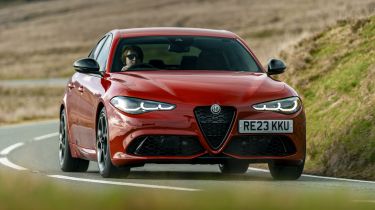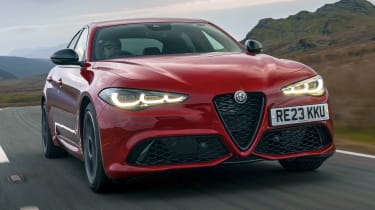Alfa Romeo Giulia review - Engines, performance and drive
The 2.0-litre petrol engine offers great performance, and overall the Giulia is a delight to drive

The Giulia nameplate has a rich history with roots stretching back to 1962. This four-door executive saloon makes extensive use of lightweight materials, such as carbon fibre for the driveshaft and aluminium for some chassis parts and the bodywork, including the suspension sub frames.
It means Alfa has given the Giulia 50:50 weight distribution, which should make the car great to drive. Double-wishbone suspension takes care of damping at the front, while a multi-link rear set-up means no corners have been cut to deliver great handling.
The first thing you’ll notice after setting off in the Alfa is the quick steering, which feels great through a series of turns. It’s accurate, too, so you can have confidence placing the car where you want it.
The chassis is also sharp, although at first the Giulia can feel nervous and hyper-alert because its steering is that sensitive, particularly in the Dynamic setting. However, once you get used to the rate of response, you learn to use less lock and the Giulia’s reactions feel more natural.
Alfa Romeo’s DNA selector means you can choose from three driving modes in the standard cars: D for Dynamic, N for Natural and A for Advanced Efficiency (the Quadrifoglio also gets a Race mode). These allow you to alter the steering weight and throttle response, but the car feels at its best in the Natural and Dynamic modes, with the 'A' setting taking a bit too much away from the car's responses. It’s not as involving as a BMW 3 Series, but the Giulia serves up enough engagement to keep keen drivers interested.
For the most part the Alfa handles bumps and imperfections well in the Natural setting, or with the adaptive dampers (standard on Competizione models) in their softer mode, but some surfaces and potholes do send a shockwave through the chassis, with some lateral wobble noticeable.
Used - available now

2019 Alfa Romeo
Giulia
30,905 milesAutomaticPetrol2.0L
Cash £22,995
2021 Alfa Romeo
Giulia
13,700 milesAutomaticPetrol2.0L
Cash £30,995
2021 Alfa Romeo
Giulia
22,795 milesAutomaticPetrol2.0L
Cash £29,995
2021 Alfa Romeo
Giulia
13,432 milesAutomaticPetrol2.0L
Cash £29,995By and large the Giulia offers a decent level of comfort, although it’s clearly set up for sportier dynamics. This is helped by the limited-slip differential (on Veloce and Competizione models), which further boosts agility.
An eight-speed automatic gearbox is standard on all UK cars, and it's a reasonable unit, providing fast shifts when required. The large paddles behind the wheel feel satisfying to use, which helps bring back some of the driver engagement lost with the lack of a manual model. However, the gearbox isn’t the smoothest-shifting unit – manual mode can feel quite jerky, and while in auto it slurs shifts better, it still doesn’t have the precision of an Audi A4’s dual-clutch set-up.
The hot Giulia Quadrifoglio is superb to drive, with incredible performance, balanced handling and a great soundtrack – we think it's a genuine rival for the BMW M3 and Mercedes-AMG C63.
0-62mph acceleration and top speed
Following the Giulia’s facelift in 2023, the Italian saloon only comes with one engine now: a 2.0-litre four-cylinder turbocharged petrol engine that produces 276bhp and 400Nm of torque; enough for 0-62mph in 5.7 seconds and a top speed of 149mph. The engine matches the chassis’s keenness to perform and revs freely with a nice rasp.
The only other version still part of the Giulia line-up is the hugely powerful Quadrifoglio model, which features a 2.9-litre V6 with 503bhp and 600Nm of torque. It’s turbocharged, but the Ferrari influence on the unit is clear once you try it. This engine loves to be revved and feels more like a naturally aspirated unit than the rival BMW M3’s turbo six-cylinder.
With a 0-62mph time of 3.9 seconds and a top speed of 192mph, the Quadrifoglio has an incredible amount of performance on offer. The V6 sounds great, although the howl always seems cut short when you hit the limiter – it sounds like it could rev even higher than it does.
If you decide to go down the secondhand route, there's more engine options. The torquey 2.2-litre diesel (now discontinued) came in two power outputs: 158bhp or 187bhp. It has a different feel to the diesels on offer in the car’s German rivals, with a much more linear power delivery. It also feels keener to rev, so it’s more fun to drive quickly. The downside is that there’s not the same muscular feeling that comes from the huge lump of torque at the bottom of the rev range so often found in other modern diesel execs.
At least the engine is well suited to the sporty Italian persona of the Giulia. At the test track, the Alfa matched the BMW 320d from 0-62mph with a time of 7.1 seconds. Once it was rolling, the Giulia was able to use its 450Nm of torque and the closely stacked ratios of its standard eight-speed auto transmission to good effect. The lower-powered diesel manages the sprint in 8.2 seconds.
There was also a 197bhp version of the petrol Giulia, which managed 0-60mph in 6.7 seconds, and with eight gears in its transmission, it was also rapid during our in-gear assessments, pulling strongly from low down thanks to a combination of strong torque and the car's low kerbweight.












